Peter Pan: Diamond Edition
by Ben | February 14, 2013 6:41 pm
Walt Disney Productions (February 5 1953), Walt Disney Home Entertainment (February 5 2013), Blu-ray plus DVD and Digital Copy, 77 mins plus supplements, 1080p high-definition 1.33:1 original Academy ratio, DTS-HD Master Audio 7.1 and Original Mono, Rated G, Retail: $44.99
Storyboard:
In her last night in the nursery, Wendy awakes to find Peter Pan, the mythical hero of the stories she tells her younger brothers, right there in their room! Offering to whisk them away to the magical Never-Land, where children never grow old, Peter and his pixie Tinker Bell leads Wendy and the boys past “the second star to the right and straight on ’till morning”. However, unbeknown to him, the infamous Captain Hook awaits, crazed from the last time he fought Pan and lost his hand to a crocodile, and eager to meet his opponent for another showdown…
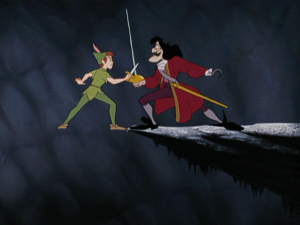
The Sweatbox Review:
How wonderful that Peter Pan, one of Walt Disney’s most defining and entertaining of all features, has finally joined the ranks of the Studio’s digitally restored films, alongside Snow White, Pinocchio and Dumbo as a purely enjoyable classic. First released in 1953 – sixty years ago exactly to the day that this new Blu-ray hit shelves – Peter Pan marked a return to form for Walt, who had bounced back triumphantly after the war with 1949/50’s Cinderella but then stumbled again with what critics of the time felt was a mishmash version of Alice In Wonderland (1951), now of course seen as something of an avant-garde masterpiece. Both Alice and Pan were based on English literary sources, and as such Walt was keen to remain faithful to their texts, dragging out production of the films to, in Pan’s case, which was intended to follow Snow White as the second feature, over ten years. It’s exactly this attention to detail, and putting the brakes on a project until it was ready to come to fruition, that Walt excelled at and indeed made each picture stronger, leading to an almost perfect representation of Peter Pan onscreen (a 2003 remake seems more indebted to being a prologue to Steven Spielberg’s Hook than true to James Matthew Barrie’s original).
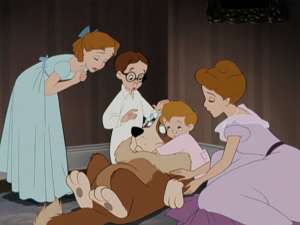
The plot is perfectly suited to Walt Disney, himself a boy who never grew up, and who created his own worlds of imagination. It’s also the most out and out magical – an overused word – of all of Disney’s films, being set almost completely in another time and place. Likewise the characters take on their own hyper-real world personas. Each comes to the screen in simple, economical storytelling fashion. Wendy is growing older but wants to retain her youthful innocence; Tinker Bell, or Tink, is the jealous type; John is an adventurer, totally off in a land of his own though perhaps wanting to be taken seriously; Michael is the youngest, happy to go with the flow, and the rest of the Never-Landers, including the Lost Boys, are a mixed bunch comprising all humanity, but mostly a feeling of loneliness and not belonging anywhere stable. A problem for some may be the racial stereotypes that would never be gotten away with now: indeed the Native American Indians, played here as somewhat comical savages, were markedly absent from the surprisingly poignant 2002 rehash Return To Never-Land. But then, is this a comment on the time or not? The Pirates, each one more stupid than the last, get the same treatment, so it’s more a case of the adults being silly while the children are ironically the more mature, surely as per Barrie’s intentions.
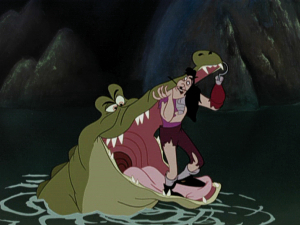
Peter himself is something of an enigma, and while many have praised the film’s comical villain Hook, let us not forget this is a guy with a very real and valid reason for revenge, which itself places some doubt on Peter’s state of mind as well, and who dupes innocent kids into a trap, is willing to throw them overboard to a waiting croc, and who attempts to kill our hero outright with an actual bomb! Any complaint that the back-stories that led to these feelings remain un-elaborated upon and that the characters could be described as somewhat un-rounded misses the point…Barrie’s Pan was originally developed as a pantomime-styled stage play – and an interactive one at that – and the film retains this feel. Also, being a film instead of a play did lend Walt and his artists some extra leeway: unlike Alice’s Tenniel illustrations, there was no set appearance for how the characters should look, so more freedom could be taken with the visual development. There are also changes to the interaction in that where we were once asked to clap furiously and show our belief in fairies in order to revive Tinker Bell – something that wouldn’t have worked in a screen version – we are instead involved in a dramatic moment of suspense.
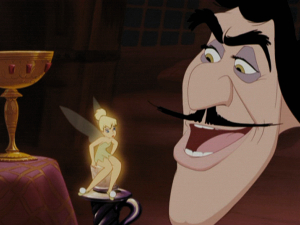
At the same time, this isn’t always a great story – Barrie’s fault, not Walt’s – for role model females. Wendy is in awe of Peter, Tink is jealous of Wendy, the Mermaids are out for themselves and even Tiger Lily seems to be pretty loose when it comes to settling down. In fact, the only “woman” to come out of Pan very well is Pan himself, since he was usually portrayed by a female actress on stage. Walt’s film marks the first time the character was represented as male, voiced by Disney child star Bobby Driscoll of Song Of The South fame. That’s not to say that Pan is strictly a boy’s own picture, since girls can get a big kick out of enjoying the character’s soap-styled green-eyed conflicts playing out, and the romantic fantasy of the “will they or won’t they” kind keeps the chemistry bubbling between Peter and Wendy, and at least the film does boast one headstrong female role. For Peter Pan is also notable for being the first time Tinker Bell developed into a real woman with human attributes instead of being just a sprite depicted on stage as a simple ball of light that floated around the set. The often-told misconception is that Tinker Bell was modeled on sex-bomb du jour Marilyn Monroe, and given the blonde connection and unmistakable body shape it’s an interesting bit of trivia to ponder over.

This has been disputed over the years, perhaps in case the owners of Monroe’s likeness sued the Studio, and the official line is that Tink’s live-action model Margaret Kerry (a brunette we must remember) inspired Marc Davis and the animators. Even though Walt himself added fuel to the Monroe flames by admitting such in a magazine article, it’s since been said that it couldn’t possibly have been Marilyn’s physique that was incorporated into Tink’s design because she wasn’t a big enough name to have had any influence. But this is actually incorrect to assume Monroe wasn’t a “face” in Hollywood at the time, having already starred with the Marx Brothers in Love Happy as far back as 1949, enjoying poster-billed bit parts in such notable films as John Huston’s The Asphalt Jungle and All About Eve in 1950, and headlining a slew of Fox comedies in 1951-52, while Peter Pan was in animation. By the time Pan was in release, she was a huge box-office draw, with the iconic Niagara, Gentlemen Prefer Blondes and How To Marry A Millionaire appearing in 1953 alone. If Kerry gave Tink her movement and legs, I still like to think that the animators added a bit of blonde Marilyn in there too, whatever the certified explanation is.
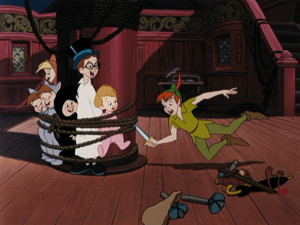
Although Tinker Bell is perhaps the most well rounded character in the film, she never talks, leaving the vocals of the film down to a line-up of well-known Disney voices of the time. Driscoll, of course, creates the world’s first male Pan, and brings a fresh take on the character, sounding young and carefree, and ready to take on anything. He’d come to prominence as Walt’s first contract star, having been discovered for 1946’s Song Of The South and appearing in the subsequent So Dear To My Heart (1948), and Walt’s first live-action picture Treasure Island in 1950. In one of two career-defining roles, Driscoll’s Pan stays true to the original intent: full of bravado when needed, but a spoiled little boy when he doesn’t get his own way, and kudos to the screenwriters for not subtracting this trait and making Peter a bland hero figure. Unfortunately, Pan was to be Driscoll’s last film for the Studio and despite early Academy Award recognition and good notices for his excellent performances in other films, most notably when he was loaned out for RKO’s terrifically tight little thriller The Window (1949), he became one of the many young names that got dragged down into Hollywood’s seedy spots, and died just a few short years later, unhappily mirroring and unintentionally strengthening his bond to Pan by sadly becoming a boy who never grew up for real.

Also returning to the Studio, after providing the lead for Alice In Wonderland, is Kathryn Beaumont, essentially playing the same English lass part, while she is joined by her Alice co-star Bill Thompson as Smee, being given much more to do with a great character this time around. Long-time animation vocalist June Foray pops up as a mermaid and an Indian squaw, and even Tink’s live-action model Margaret Kerry gets a line in as another mermaid. The voice cast is among the best of Disney’s features, with not a weak performance in the entire picture. Best of all is Hans Conried, suitably snarling and menacing as Hook, and sympathetic as the post-Never-Land Mr Darling, as per continuing the theatrical tradition of having the same actor play both roles. Conried would become an animation favorite and went on to lend his voice to numerous Disney films, most memorably becoming the face of the Magic Mirror in many later TV appearances. Staying with the sound, and the score, by long-serving composer and underrated musical genius Oliver Wallace, and songs are among some of Disney’s best, written by Sammy Fain, Sammy Cahn and Frank Churchill among others. Is there anyone for which The Second Star To The Right doesn’t conjure up the sentiment of When You Wish Upon A Star but without the cloying corniness, while You Can Fly! excels at creating a song that lifts one up even when not accompanied by the film’s soaring over London images?
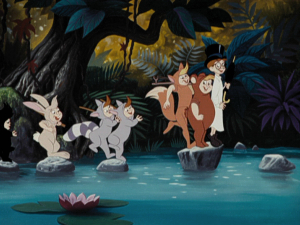
Following The Leader has entered popular culture to the extent of Whistle While You Work from Snow White and is unquestionably the film’s one true out and out comedy moment, a place to have fun before the tension racks up for the following face off between Pan and Hook. The poignancy of Your Mother And Mine, is expertly handled, wherein Wendy realizes that she’s growing up and it’s a natural thing to be happening, like it or not. All of which are transparently interwoven cleverly throughout by Wallace’s orchestral music, lush and restrained when needed, but also full of big brassy moments including the signature three-note fanfare for our hero. Unbelievably, neither the songs nor score were even nominated for Oscars, although Disney did pick up four awards that year for other releases. But, as good as the soundtrack is, an animated film is all about the images it provides and in Peter Pan’s case we’re treated to some spectacular animation – another reason it’s remained one of my favorites. Lines are clean as they would be in later fare such as Lady And The Tramp and Sleeping Beauty but retain a looser feel that allows for the broad strokes of the story to play out.

It’s almost as equally opulent as Pinocchio: each line has been individually colored, and if there’s any film (perhaps apart from Pinocchio) from the Walt-era library that looks like it could have been created with the Studio’s digital animation process, then this is it. The three-dimensional shot looking down as Hook climbs up the ropes, sword in hand, toward Pan is simply stunning, water glistening in the background, and the dark lighting instantly suggesting the shift in the film’s tone, and Hook’s relentless desperation. Added to this is the sheer perfection of the largely human cast, always a struggle to animate convincingly, but by this time the artists were at the top of their game. What’s most effective is the feeling of weightlessness they are able to infuse into their essentially weightless drawings. How does an animated character actually fly without seeming as if they are merely floating? Directed by Clyde Geronimi, Wilfred Jackson and Hamilton Luske, Peter Pan answers this dilemma expertly, continually moving the characters throughout the air and even giving them a way of thrusting themselves forward that really looks as if they are powering themselves along. When they shoot off over London and the clouds part beneath them to reveal the city, one could almost fall into the shot, such is the depth to the artwork.
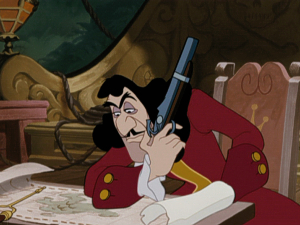
The rest of the more earth-bound humans are good too, not least Mr Darling, who carries his own weight with the grace of a true theatrical performance and call back to the story’s stage origins: after a short-story book debut, Barrie brought Peter Pan to the stage in 1904, which was later adapted with the earlier material into the well-known novel we know today. The loosely biographical Finding Neverland, with Johnny Depp as Barrie (and well worth seeing!), is a good account of the creation of the story, based on the author’s own encounters with those who had captured the innocence of childhood but finding them having to balance that against growing demands of adulthood. Walt’s film, although the only major adaptation not to use any of Barrie’s actual stage dialogue, does retain some of the deliciously dark undercurrents from the original, though they will go unnoticed by the younger set. Walt was perhaps mindful that Alice had taken so many liberties with Lewis Carroll’s source novels, and had been particularly criticized in its native Britain…a feat he didn’t want to repeat. As such, Pan is as faithful in spirit an adaptation as they come, right down to Conried maintaining the stage tradition of playing the dual roles of Hook and the Darling children’s father.

As the latter, he brings a warmth to his role that suitably ties up the film’s last line, whereupon it is clear that Pan’s message isn’t so much about children needing to grow up, but for the adult not to lose sight of the child within them…classic Disney sentiment shared with Barrie’s sensibilities. These dynamics really help in the exciting moments too, and Pan is one of Walt-era Disney’s most action-packed films, with plenty of swash for your buck. Even in the pause for breath of Your Mother And Mine, the plot continues to move forward, as Hook, Smee and their crew get ready for their ambush of the Lost Boys. These touches never stop: as well as Tink we’re presented with first-time views of the “real” Darlings’ St Bernard nanny-dog Nana and the infamous Crocodile, only ever seen as actors in costume and props on the stage. “You’d never miss them but they’re here” moments also include Hook’s swapping of his silver hook for a gold plated one in order to charm Tink, revealing the many other devices he’s able to twist on to his hand, and Tinker Bell’s ubiquitous pixie-dust, which simply visualises “magic” incarnate…just great touches that add so much to already immensely enjoyable entertainment.
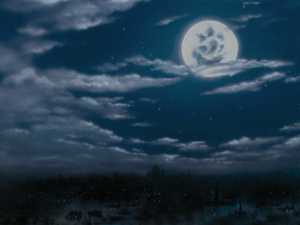
When I was five, and VHS piracy was but a glint in the eye of the guy with the first linked up tape-to-tape configuration, tapes of older movies were passed around the movie industry without much thought. I was thrilled when my Dad brought home a slew of Disney pictures, Snow White, Dumbo, Lady And The Tramp, One Hundred And One Dalmatians, The AristoCats and Peter Pan among them, along with Superman: The Movie, and its these early viewings that I put down to my life-long appreciation of the classic work from the Disney Studios, as well as Superman remaining my favorite film of all time. As one is able to do when they are a child, I made no distinction between Disney and Warner Brothers at that age and lumped Superman and Pan together in an unofficial double bill: both films concerned heroes that fly, of course, and Superman even makes reference to the earlier story about the Boy Who Wouldn’t Grow Up. At my ripe old adult age now I can appreciate that Superman too is essentially a fable for the big kid in all of us, but at that time I thought of Peter Pan as “Superman for kids” and as such it also quickly became one of my favorite films, and is unquestionably still my top pick from Walt Disney’s “middle period” of the late 1940s and the 1950s.

Pan was the last feature length movie all of the Nine Old Men would work on in the capacity of directing animators, after which one could say that the films became more fragmented, especially without Walt’s personal touch. By this time he had become interested in live-action picture making, the thought of expanding into television was already strong in his mind, and of course his own Never-Land, the theme park that would bear his name, was very much a priority project for him. Another change at the Studio would be the way the films were distributed: a spat with RKO over their refusal to support the first feature-length True Life Adventures documentary led to Walt setting up his own distribution company, Buena Vista, later to be rewarded with much success, a new series of nature films and multiple Oscar nominations and wins for those films. Pan was to be the last animated feature to carry the RKO title card, perhaps adding another layer of irony in that the film was released in the year that Walt himself stopped being the young hot-shot wunderkind of Hollywood and became one of the big boy players himself.

Although Pan wound up being a massive commercial and critical hit, which went on to enjoy many successful theatrical reissues before coming to home video in the 1990s, Walt himself was apparently disappointed with the end result, especially mindful that he felt an audience could never care for Pan as a character. He’s an adolescent in all manner of ways…having fun but not caring about the consequences; selfishly unaware of his actions and that bringing the kids to Never-Land is itself a dangerous proposition. It’s true that he is arrogant too, because he’s essentially a teenager finding his own place in his world, but Pan simply comes across with such an extremely charming manner…something that would definitely appeal to any child, boy or girl. And that’s also why Peter Pan works – it is a thrilling adventure that plays to both sexes and all ages, un-tinged by Walt’s sometimes over sentimentalism until the very end, when resorting to the cliché is actually perfectly judged in creating the most wonderful closing moment. Perhaps this is why Peter Pan has lasted for fifty years: it will no doubt continue to remain the most mischievous – and youngest – of all the Disney pictures!
Is This Thing Loaded?
For one of Disney’s more perennial moneyspinners, Peter Pan never seems to have quite enjoyed the luxury on home video that other films of its period have done. This is largely rectified in this Diamond Edition at last…up to a point. The set’s main menu is easily more elaborate than usual: a computer animated “map” of Never-Land that whisks us around the story’s various locations neatly if a little too digitally. But it’s a nice touch and indicates that the set has been assembled with some thought and attention, even if the best material is what we have seen before and there are still gaping holes in what could have been preserved and presented here. Of the new material, an Introduction by Diane Disney-Miller is as brief as these things usually are at around one minute, but does lean more toward discussing the movie instead of simply playing as a promo for the Disney Family Museum in San Francisco, as some of these intros can feel like. Nevertheless it’s always great to take a peek at the Museum’s Collection, and nice to see some of the Peter Pan material they have in their archives.
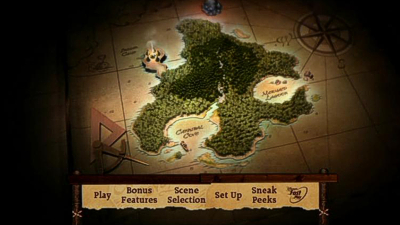
Diane was, of course, Walt’s daughter, and it’s the offspring of another Disney collaborator who is behind the set’s lengthiest new offering. Produced by animator Frank Thomas’ son Ted, who has taken it upon himself to document his father and colleagues’ work in such feature documentaries as Frank & Ollie and Walt And El Grupo, the new documentary Growing Up With Nine Old Men surely has a “The” missing from its title? Disney fans will immediately cotton on to what the title implies, but it could be mystifying for others who might not know that “The Nine Old Men” were what Walt used to call his innermost trusted artists at the Studio, akin to the Pixar Braintrust and Disney Storytrust that John Lasseter has in place at the modern-day company. With retrospectives on their careers having been the focus of many a Platinum and Diamond Edition in the past – and the slightly tenuous link of having today’s animators speak about meeting them in a supplement for Cinderella’s release, this is kind of “Son (and Daughters!) Of The Nine Old Men”, in which we meet their offspring and where their lives have taken them.

Growing Up With (The) Nine Old Men is the kind of extra that will split viewers right down the middle: at once a fascinating look at how the real “children of Disney” turned out for truly hard-core aficionados, I can see that it could also be a slow (by its very nature as a talking heads catch-up) and potentially mind-boggling “what the heck?” trek of boredom for anyone but. Count me somewhere in the middle, but heavily leaning towards the enthusiast’s side…I wasn’t ever uninterested (I’ll eat anything up if it’s to do with classic Disney) and was very pleased to “meet the kids” and see such things as their homes – including Milt Kahl’s and his amazing wire sculptures – as well as home movies and “hidden” artwork by these master artists kept by their families, but the result isn’t quite as engaging for wider audiences as Thomas’ previous outings. This also isn’t really the feature-length documentary that earlier press announcements suggested, coming in at just 41 minutes and without any official titles or credits, although it’s shot very nicely, edited very nicely, and is warmly unpretentious even if it’s all pretty safe and doesn’t make any startling revelations.
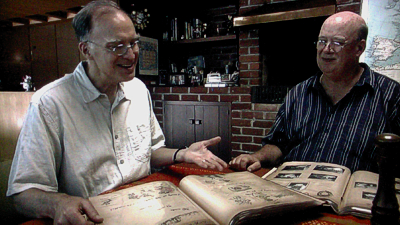
Presented in HD, it’s a bonus feature, pure and simple, and one that will either be of interest or one that some may not even make through once and never watch again. I was somewhat disappointed that Bruce Reitherman, the son of Woolie who got to voice Mowgli, earlier provided the original voice for Winnie The Pooh And The Honey Tree’s Christopher Robin and perhaps so had the most heavily Disneyfied connection in his upbringing, didn’t reference this fact in the discussion with his two other brothers which, Thomas aside, makes him unique among these faces. But for the record, I enjoyed this peek into the lives of those who grew up with some pretty special people as their fathers immensely, although with only a couple of the “kids” following their parents into the artistic business and most becoming office-bound lawyers and such, most probably won’t feel the need to rush back to it again too quickly. However, none of the children seem to have resented their backgrounds, and how bad must it have been having a Disney Dad if it meant being able to go on to law school or simply enjoy the leisurely lives that they seem to have. Perfectly lovely, and the themes of family and growing up make for this to be a suitable companion for the main feature.
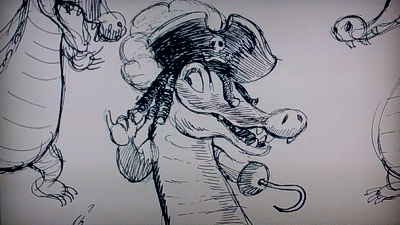
Also in HD are a couple of other new additions: two Deleted Scenes present an Alternate Arrival (5:22) in Never-Land for Peter, Wendy, John, Michael and Nana, who was originally to have accompanied them all on their trip, from the 1930s storyboard treatment and from which some of the ideas made their way into another sequence in the completed film. The Journey Home (4:38) presents an entire alternate ending and, while there are several good ideas to be found here – especially the children’s goodbyes – it easily needed to be trimmed down a tad even if it does successfully retain more of Barrie’s original. One of two Deleted Songs isn’t a “deleted” track at all as it was never intended to be sung in the film: Never Smile At A Crocodile (2:13), although featured in Frank Churchill’s instrumental score for Hook’s nemesis, was given lyrics after production wrapped and released, in the style of many of today’s animated films, as a record of its own. Covered by many over the years, it’s the Henry Calvin (Disney’s Zorrotelevision show) original we hear here, while The Boatswain Song (3:15) presents a demo recording for a cue written for the 1939 treatment of the movie, and a very typical kind of tune for that time.
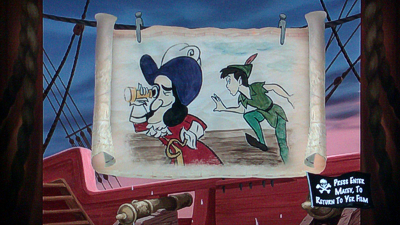
The Blu-ray also offers a new Disney Intermission update, this time featuring pirate games and activities when the movie is paused, but that’s it for the new stuff – well, if one doesn’t count the Disney View option of running artist Cristy Maltese’s perfectly fine but distractingly static side panels alongside the movie’s framing – leaving a selection of material ported over from the previous Platinum Edition under the Classic DVD Bonus Features banner. Disney’s Song Selection is again nothing more than the usual alternate Scene Selection option that offers up the movie’s song sequences (except for What Makes The Red Man Red?) in abrupt fashion complete, if needed, with on-screen lyrics, a subtitle track also selectable as a Sing-Along With The Movie option. Turning up for the third time on disc is an archival feature-length Audio Commentary hosted by Roy Disney, previously heard on Pan’s Special Edition and Platinum DVDs. However, the good news is that if you’re coming to it for the first time or if you’ve heard it before, it’s still an amazingly packed track worth another go, even if Roy’s dry voice betrays the fact he’s reading most if not all of the information from notes.
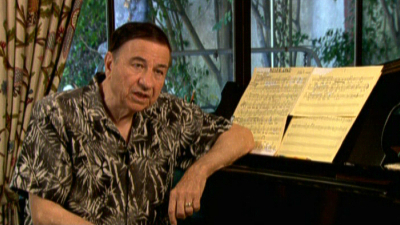
Fortunately, his voice is punctuated throughout by other pre-recorded comments from notables such as Leonard Maltin, Marc Davis, Kathryn Beaumont, Frank Thomas and Ollie Johnston, Ward Kimball, John Canemaker and vintage recordings of Walt himself, among others. Although fragmented by design, the remarks have been mostly edited well to the goings on happening on screen, though not always scene specific, but there’s never a silent moment. While I would not have expected a newly minted track, at least a previous one hasn’t been dropped. In Classic Music And More, previously seen material includes a Deleted Song: The Pirate Song (now apparently in HD) that duplicates the 2:22 acetate recording and storyboards from a making-of documentary, found elsewhere on this disc, in stand-alone form, and Never-Land: The Lost Song, a delightful piece that has later Disney composer Richard Sherman musically completing an unfinished lyric for a tune from another abandoned 1940 version of the film. I always love spending time in the company of Sherman, and the two-and-a-half-minute introduction really shows his love for all things Disney.
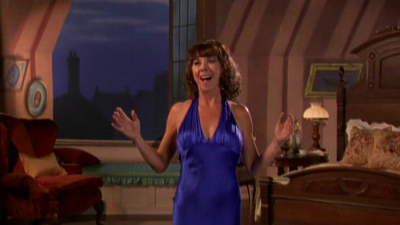
Better still, Belle’s singing voice Paige O’Hara was drafted in to record the song for the Platinum release and the full 3:15 Never-Land music video, set in the Darlings’ nursery and also selectable from its own menu option, is something quite special. Much less so is The Second Star To The Right pop version performed by Disney teens (or, by now, surely adults?) T-Squad, from the DisneyMania 5 album. Unlike previous Disney pop tunes, this one bears little resemblance to the original melody at all and is simply one minute of pure promotional filler (for “filler”, read “cr*p”!). Moving into the Classic Backstage Disney section, one might really be hoping that The Walt Disney Christmas Show, a 1951 special that was promised for the Platinum Edition but was a no-show, just might be found, but we’re out of luck. The same goes for any kind of lengthy documentary or detailed analysis of the production’s development, as is the norm for the Platinum and Diamond Editions: the closest we get is You Can Fly: The Making Of Peter Pan, which actually dates from as far back as the 1990s LaserDisc release and runs for 16 – yes, just 16 – minutes!
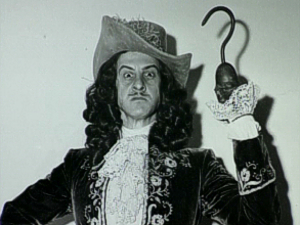
Though this is a quickly paced and essentially valuable piece, it hasn’t been added or expanded upon, and the interview segments, especially featuring a much younger Leonard Maltin, who used to host these programs at this time, belie the age of the material. For first timers (and after four or five releases how many can’t have already seen this?), the storyboard section and deleted pirate song (the one also repeated elsewhere) will enchant, but there’s certainly the space for something more substantial, and the glimpses that Walt Disney Christmas Show that is again missing from the line-up here are especially frustrating! In Walt’s Words: Why I Made Peter Pan is a great inclusion, but short at less than eight minutes. Intro’d for some reason by still-current Disney directors Ron Clements and John Musker, the pair explain how an article written by Walt himself was “recently” discovered in the archives. Even with the new material, this is very nearly still the best thing in this set, reconstructing the story using a terrific sound-alike for Walt’s voice as heard in the Story Meetings reconstruction on the Bambi disc.

Walt explains how he came across the story as a young boy, how he played Peter in a school play and the eventual process of turning Barrie’s adventure into one of his animated pictures. Visually, re-enactments of Walt’s early days have been created in non-too-authentic video, and accompanied by the usual Studio archive footage and tremendous amounts of production art this could have been coupled with the commentary to recreate that same Story Meeting format, but that this featurette lasts less than eight minutes and is acknowledged to be an abridged version again shows the lack of the original Platinum Edition’s ambitions and the Studio’s refusal to go the whole nine yards in returning to create a definitive Diamond release for one of their most popular titles. The light ‘n’ fluffy Tinker Bell: A Fairy’s Tale (again seemingly now in HD) is an 8:25-running featurette looking at the impact the character has had since her creation as a ball of light in Barrie’s original play and first screen appearance in Paramount’s 1924 silent feature, to her role in Walt’s take and the live-action reference participation of Margaret Kerry and further career as a figurehead for the company, second only to Mickey Mouse.

Despite its validity as a commentary on this important face in Disney’s lexicon, I originally questioned this rather unusual focus on a secondary character and saw it as a stealth-like promotion for the then-upcoming new series of Tinker Bell films emerging from the DisneyToon Studios, but a bit of time between the Platinum and Diamond editions has given it new life as a fair profile, with only a brief look at the progression of the character as a CG video star now seeming like an oversight! Still…since when was Tink a fairy, exactly? She had always been a pixie until those new movies! Better is another repeat, The Peter Pan That Almost Was, which does go into the development of the movie far deeper than any other bonus here. Before the legendary Mary Blair’s concepts informed the design of the eventual movie, artist David Hall created art for a much earlier 1930s version of Peter Pan that never made it to the screen. Here those works are highlighted among others, again by current Studio directors Musker and Clements, in the finest supplement here.
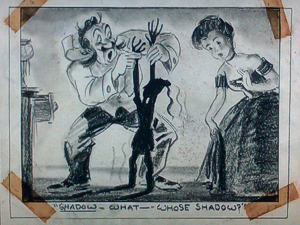
Running a generous and healthy 21 minutes, we’re taken back to the development of the movie, covering two alternative openings, deleted concepts (including Nana’s journeying to Never-Land along with the Darlings, and John’s staying in London), and even one sequence that ended up in Steven Spielberg’s later Pan sequel Hook. Even though it’s been previously seen by most, this is still an excellent and informative piece beyond anything else in the set, even if it doesn’t really touch on the proposed live-action bookends that had Wendy, John and Michael reading the book that comes to life in animation from an early presentation. There’s some more vintage, time-of-production footage in The Peter Pan Story, a black and white 1952 publicity featurette, running 12 minutes, that was created by Walt to run on TV to promote Pan. A dryer than usual Disney piece, Walt is less the showman and more the salesman in his producing role, starting the piece with a re-cap of great homespun storytelling through the ages (even including excerpts of Song Of The South, purists!) and creating hype around the apparently demanding task of bringing Barrie’s Pan to the animated screen.
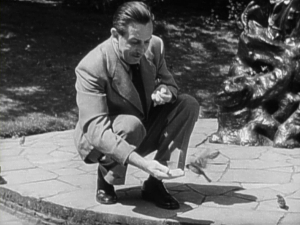
The closest thing we get to any publicity (there are, again, no trailers or that Christmas Show program), this would be a unique archive addition had it not been seen by anyone for years, but there’s no getting away from the fact that this featurette made its home video debut almost twenty years ago on LaserDisc and popped up again on both previous DVDs. That this is the promotional item that contains the most footage to be sampled in the other supplements also dims its wow factor somewhat, and the final few minutes of clips is as blatant a tease as they come. On the included DVD, there’s nothing more than Disney-Miller’s Intro and the Fairy’s Tale featurette included, while Sneak Peeks across both discs include The Little Mermaid, Monsters University, Wreck-It Ralph, DisneyJunior’s Jake And The Never-Land Pirates and Sophia The First, Return To Never-Land, Monsters Inc. Blu-ray, The Many Adventures Of Winnie The Pooh, The Muppet Movie: Almost 35th Anniversary Edition, Mulan & Mulan II, a sneak peek at the next Tinker Bell movie (surprisingly not given more promotion given the titles’ connections), and…sigh…Planes, again.
WHAT’S MISSING?
When Peter Pan came to Platinum Edition DVD, I was disappointed that my favorite Walt-era film did not stack up too well in anything that was compelling or even new. Many features had been lifted from the previous 45th Anniversary LaserDisc, Limited Edition or Gold-styled Special Edition DVD versions, with only the announced Walt Disney Christmas Show from 1951 – in which Driscoll himself appeared for the only time as a live-action Peter – holding any intrigue. I became very excited when it dawned on me that this show was a precursor to the Disneyland television program, and was the second (and final) such special after One Hour In Wonderland before Walt began his weekly show proper in 1955. But…alas, as we all too disappointingly found out when Pan finally arrived, that important archival program – and the one thing that I was interested in from a valuable extras point of view – was a no-show. Surely they wouldn’t make the same mistake again with Pan’s fairly extras-light release on Blu-ray!?
Well, yes, of course we now have confirmation that the Christmas Show is very much missing from this set – again! – which is an extremely disappointing situation indeed, and one that overall sinks Peter Pan’s treatment in the Blu-ray supplemental stakes to the very bottom of the pile. Even recent Diamond updates for Lady And The Tramp and Cinderella pulled off unexpected feats of largely bettering their original DVDs! The new addition of Ted Thomas’ Nine Old Men documentary is a clear plus, albeit one that won’t be a hit with all fans, but the worst thing is that this new disc doesn’t even pull over everything from the previous edition. Okay, a Tinker Bell preview for the debut CG movie was both disposable and now dated, so there’s no great shakes that this isn’t repeated, and you won’t get many complaints from me that a read-along story and some set-top games have been dropped, while I’m actually super-pleased that a totally redundant version of the entire movie with burned-in subtitles has been consigned to the trash heap!
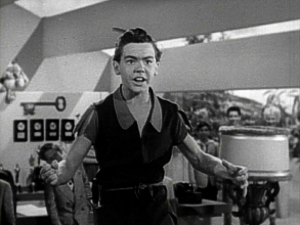
Christmas Show – NOT on this Blu-ray edition
But where are David Hall’s concept artworks from one of several Art Gallery options that offered up over 450 images covering visual development, Mary Blair’s concepts, character design, storyboards, layouts/background, production stills, the live-action shoot’s reference photos and publicity shots? Someone putting the Platinum DVD together certainly had their head screwed on with these top-notch galleries: somebody needs to be fired for leaving them out here! Publicity is short-served elsewhere, too, without any of the film’s previews or reissue trailers, depicting how Pan was marketed over the years, reinstated here, a rarity for a Platinum edition but sadly par for the course in the Diamond line, and yet another disappointment. The included commentary is nice, but it’s a rehash from two previous releases, and the lack of a new “making of” featurette really is a poke in the eye, the one that we do have again lifted from previous editions, as is The Peter Pan Story.
The lack of those theatrical trailers is appalling in that this should be a definitive version, while the LaserDisc pressing also contained audio-only extras such as storyboard presentations for two alternate scenes, plus additional art and live-action reference galleries. Since this material was available, why the no-show here, and considering Peter Pan’s evergreen status, why not more of the ’specially produced features that used to grace Disney’s premium titles, such as anything on long-serving Studio cast members Beaumont, Driscoll and Conried, or a note on Disneyland’s still-popular ride? In other territories, Pan has sometimes been accompanied by the complete 1924 Paramount silent feature, wonderfully restored, but only glimpsed at here. Pan seems to still be some kind of casualty in terms of this Diamond set being less a celebration of one of Walt’s most successful films, and little more than an assemblage of archive material of various vintages; while one could make the argument that these are “older” films and do not have the supplements available to round out these sets, we know that this just doesn’t wash.
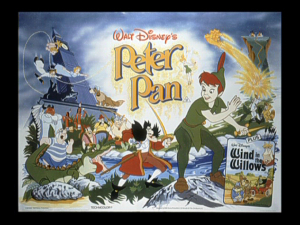
artwork galleries – NOT on this Blu-ray edition
Disney has always been spectacular at archiving all the production processes of its animated films, and there is certainly the material in the vault to bolster Pan’s Diamond Edition to being something better than a Platinum repeat that actually drops extras, in this case several theatrical trailers and that one hour Christmas Show! I know that Disney would prefer not to include the film’s never-embarrassing Return To Never-Land sequel because this is a stand-alone Diamond package, but it might not have been a bad idea to break the rule here and offer something substantially extra. Additions such as these would have absolutely warmed up this otherwise cold dinner of leftovers, and got long-time fans like me truly excited about a release that otherwise only sports an HD upgrade as its chief selling point. Thomas’ documentary at least provides something new, but recycling such a large amount of stuff at this Diamond level (some for the third or fourth time!) and omitting several important additions doesn’t warrant an impressive nod at all. Color me very disappointed, though you probably guessed that already!
Case Study:
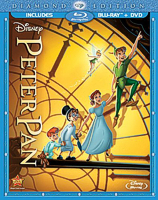 Available in two configurations – neither of which highlight the film’s 60th anniversary – I actually prefer Peter Pan’s blue-bordered Blu-ray cover art [pictured right], which is more in keeping with previous Diamond titles’ treatment.
Available in two configurations – neither of which highlight the film’s 60th anniversary – I actually prefer Peter Pan’s blue-bordered Blu-ray cover art [pictured right], which is more in keeping with previous Diamond titles’ treatment.
The difference is that the golden-hued edition reviewed here offers an additional Digital Copy disc (for $5 more), although why Disney chooses to split these releases up instead of producing complete, all-in combo packs is strange when they used to do this before.
A Storybook App (of the same kind that popped up as a Second Screen addition on the Cinderella Diamond set and merely features stories and games as opposed to any kind of collector’s content) seems to only be included in the three-disc version, it appears, although it could be that the activation code insert is also included in the two-disc edition.
Other than these minor differences, both of Pan’s edition’s cover art bafflingly focus on the Big Ben moment in the film, which lasts for just a few seconds: the golden-bordered three-disc has a rather “nothing” image of the clockface with just Peter’s shadow on it (strange that the film’s protagonist is not actually shown), while the two-disc has a much more enticing image.
It still makes a big deal out of the clockface, but the invitation and promise of the magic and adventure to be experienced in the movie is much more prevalent and capturing of the Peter Pan spirit we know. Pan is also more characteristic on the spine, while the backs of each sleeve are mostly identically designed. It’s true that one could suggest the emphasis points to the passing of time, but I don’t really think the Disney designers were putting that much level of thought into it.
Ink And Paint:
If you were expecting a pristine digital restoration that wipes away years of print debris, cel scuffs, color imbalances and the like, then this Peter Pan will not disappoint. Making it look like it was composited even more recently than its 2002 sequel, the film thankfully retains its original 1.33:1 Academy screen dimensions and reinstates what must be assumed to be a more muted, original color scheme. The Platinum Edition famously boosted colors and their hues, presenting a much different Pan to how audiences saw it in 1953 and on home video before that release, but those inadequacies seem to have been put right here, as most of these kind of things usually are for the Diamond Editions (although this does seem to use a toned down version of this same transfer). Still, Pan isn’t the top banana of transfers, at least for me, generally down to a slight lightness to the image.
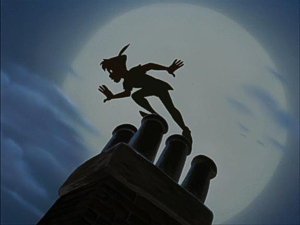
I’m not talking an overly bright picture, artificially boosted to create more contrast…but actually quite the opposite. Sharpness and detail are right there on the screen, but the image itself simply comes over, to me, as being lighter than expected and not as “deep” as most Blu-ray transfers – even of classic catalog titles – usually are. Toying with my brightness and contrast levels helped, making the shadows darker and the image more defined, but this shouldn’t be something a viewer at home should have to adjust to get the best from their discs. Other than that, things are fairly pleasing: there’s none of the slightly detectable ringing that I noticed (but wasn’t too offended by) on the Cinderella Diamond set, and purists will appreciate the appearance of the original RKO distribution card on the front of the titles.
Scratch Tracks:
Pretty much sounding as if it has replicated the basis of the Enhanced Home Theater Mix from the Platinum set, the DTS 7.1 surround here doesn’t really add anything significant to that track other than a possible less compressed feeling to the sound. As with other films from this era, the ability to spread the audio across the soundstage is more limited, but where it really scores is in giving the already lively music even more depth.
It’s not too over the top as some of these things can be, obviously down to the limitations in separating the masters, but for those who don’t appreciate these sometimes artificial manipulations, the original mono track is also included and is no slouch either, having been cleaned up and sounding just as good if not as spacious. French and Spanish 5.1 dubs, from the previous releases, are retained along with subtitles in all three languages.
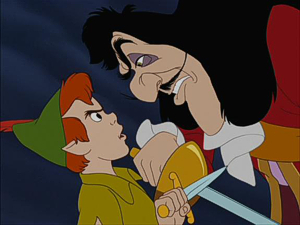
Final Cut:
While Peter Pan was a late entry into the original Platinum pantheon, I would suggest that this Diamond Edition “upgrade” is less a celebration of one of Walt’s most successful films, and very little more an attempt to put out a popular title on disc at minimal expense, regurgitating the most basic of archive material of various vintages and bringing little new to this collection in the process. The extra space capabilities of Blu-ray haven’t been used to the full here, especially in the dropping of previous supplements and in particularly not rectifying the situation regarding previously promised extras that are still a no-show here. To say that I was again disappointed with Pan on disc is nearly an understatement, but if it were not for the undeniable pull of the film, this could be a total misfire.
There was a feeling back in the Platinum DVD days that when the series went to two titles per year the quality certainly dropped, but the Blu-ray Diamond Editions seemed to have so far kept their levels more buoyant and even surpassed those previous sets in many cases. Is this a case of the folks at Disney Video being so spread thin in their ongoing drive to update the most popular titles to HD that they can’t keep up? Even the better-than-the-DVD editions of Lady And The Tramp and Cinderella don’t hold a candle to the flawed but exemplary Snow White and, especially, Beauty And The Beast BDs that came earlier in the line. The film is great and, one caveat aside, so is the restoration; Thomas’ documentary adds a point to the score, but this is essentially one of the most disappointing of the Studio’s “prestigious” releases.
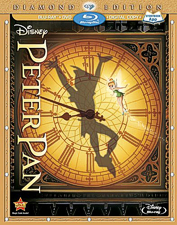 | ||
 [1] [1] |
- [Image]: http://www.amazon.com/exec/obidos/ASIN/B00A0MJ9ZA%20/animatedviews-20
Source URL: https://animatedviews.com/2013/peter-pan-diamond-edition/